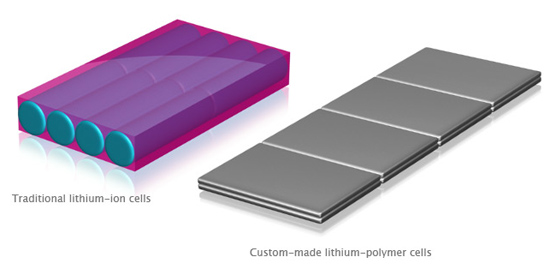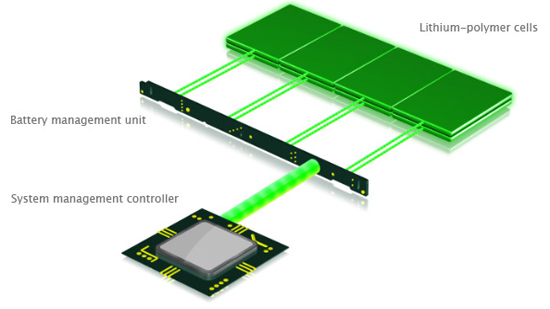Apple's 2009 MacBook Pro: Battery Life to Die For
by Anand Lal Shimpi on June 12, 2009 12:00 AM EST- Posted in
- Mac
I was so focused on the iPhone 3GS and Snow Leopard announcements from this year’s WWDC that I almost missed the gravity of the MacBook Pro announcements.
Apple announced price drops on nearly all of its laptops. The new lineup looks like this:
| MacBook | MacBook Pro 13-inch | MacBook Pro 15-inch | MacBook Pro 17-inch | |
| CPU | Core 2 Duo 2.13GHz | Core 2 Duo 2.26GHz | Core 2 Duo 2.53GHz | Core 2 Duo 2.8GHz |
| GPU | NVIDIA GeForce 9400M | NVIDIA GeForce 9400M | NVIDIA GeForce 9400M | NVIDIA GeForce 9400M + 9600M |
| Memory | 2GB DDR2 | 2GB DDR3 | 4GB DDR3 | 4GB DDR3 |
| HDD | 160GB | 160GB | 250GB | 500GB |
| Battery Life | Up to 5 hours | Up to 7 hours | Up to 7 hours | Up to 8 hours |
| Price | $999 | $1199 | $1699 | $2499 |
If you want an all aluminum body, you have to buy a MacBook Pro. There’s only a single MacBook model and it’s the white chassis that’s been around for a while now.
Apple added a 13” MacBook Pro to the lineup to fill in the gap, although it’s not clear to me whether this 13” MacBook Pro uses the same LCD panel as the old 13” aluminum MacBook or a derivative of the 15” MacBook Pro’s panel, which is superior.
 Of course there are different models within each one of these categories that you can purchase, but they are irrelevant to the discussion we’re about to have. Look at the battery life row in the table above; Apple is claiming up to 7 hours of battery on the new MacBook Pros. The old specs used to be up to 5 hours.
Of course there are different models within each one of these categories that you can purchase, but they are irrelevant to the discussion we’re about to have. Look at the battery life row in the table above; Apple is claiming up to 7 hours of battery on the new MacBook Pros. The old specs used to be up to 5 hours.
Apple did some clever work on its own here. Standard lithium ion batteries are made up of cylindrical cells, similar to AA batteries. The problem with these batteries is that they waste a lot of space within a notebook (try cramming a lot of cylinders into a box, you end up with wasted space). This wasted space translates into larger batteries than are necessary, which makes for larger notebooks.
In order to continue to drive laptop thinness down, Apple started experimenting with using custom lithium polymer batteries instead of the industry standard lithium ion parts. Lithium polymer cells aren’t made of cylindrical cells (they’re rectangular), so there’s no wasted space. Not only does this make the batteries more compact, but it also gives you greater capacity since you’re using all available chassis volume for the battery.

Makes sense. Courtesy, Apple.
Apple also found that it was wasting space in the removable enclosure for the batteries as well, so its lithium polymer offerings are no longer user removable. I suspect this part of the equation has more to do with cutting costs than saving space though.
Apple first used this lithium polymer battery technology in its MacBook Air. It gave Apple a very thin battery that allowed it to create the MacBook Air’s sweet form factor. Then came the new 17” MacBook Pro, without a removable battery. Apple claimed that this battery would last for five years before it needed replacing and resulted in up to an 8 hour battery life.

The extended life is supposedly due to an on-battery sensor that communicates with the system's management controller that can dynamically sense the needs of each lithium polymer cell and feed that info back to the charging circuitry. The result is slight variations in charging current designed to optimally charge each and every cell; apparently reducing wasted charge cycles significantly. Apple claims that most cells will hit 80% of their life after 200 - 300 charge cycles, but its special lithium polymer batteries will hit the 80% mark after as many as 1000 charge cycles. Apple claims its unique battery chemistry and microprocessor managed charging (Adaptive Charging) is responsible for these gains but it’s a difficult statement to prove; we’ll have to wait and see what happens after a few years of use.










113 Comments
View All Comments
Anand Lal Shimpi - Friday, June 12, 2009 - link
The 9600M was not present in the MBP I tested. I bought the entry level $1699 one.Take care,
Anand
ImSpartacus - Friday, June 12, 2009 - link
Yeah, I don't like that Apple doesn't say exactly what kind of processors they offer. It's depressing.Why can't AT tell us what processor the MBP has? Couldn't you just run CPUZ on Windows or something? Is it harder than I think it is?
aeternitas - Friday, June 12, 2009 - link
Apple isn't made for people that care that much about that stuff. It just doesn't matter. Faster = Faster. Expensive or not, not everyone wants to hax their way to OS X on a built PC either. Its not depressing, its simplistic and works.PlasmaBomb - Friday, June 12, 2009 - link
I should have checked wikipedia.http://en.wikipedia.org/wiki/MacBook_Pro">http://en.wikipedia.org/wiki/MacBook_Pro
Processors used in the mid '09 refresh are - 2.26GHz (P8400), 2.53GHz (P8700), 2.66GHz (P8800) Intel Core 2 Duo with 3MB on-chip L2 cache or 2.8GHz (P9700) Intel Core 2 Duo with 6MB on-chip L2 cache.
There is also an optional to upgrade from the 2.8GHz chip to a 3.06GHz (T9900) with 6MB on-chip L2 cache (costs $300).
JarredWalton - Friday, June 12, 2009 - link
Worth noting is that the P series CPUs (P8400-P8800) are generally 25W TDP while the T series (T9400-T9900) are 35W TDP. I think that's correct. Anyway, one thing that likely changed with these new MacBooks is that Apple switched to the lower TDP CPUs. Perhaps Anand can confirm?chrone - Saturday, June 13, 2009 - link
intel atom combined with this unibody batteray will do 24hours rock solid macbook mini. lol :D hope they bring that to netbook.ltcommanderdata - Friday, June 12, 2009 - link
The previous Late 2008 Unibody's 2.4GHz processor was also a P series with 25W TDP so it isn't a matter of just using lower TDP processors since it's unchanged.It would be interesting if Anand could do a battery life comparison in Windows under Boot Camp comparing the new MacBook Pro with the previous Late 2008 Unibody. If the margins remain the same between the models, then the optimization is likely in the firmware of the various components or the processor has been undervolted. If the battery life improvement margin falls in Windows, then the optimizations are in OS X.
PlasmaBomb - Friday, June 12, 2009 - link
Good call :)ltcommanderdata - Friday, June 12, 2009 - link
Actually, if you look at Apple's publicly listed processor specs for the 2.53GHz model, I'm pretty sure there is only one processor it can be. Apple quotes the 2.53GHz Core 2 Duo as having 3MB L2 cache. That makes it a P8700. The older T9400 and P9500 had 6MB L2 cache. Similarly the 2.66GHz Core 2 Duo is the P8800 just released by Intel since it too has 3MB L2 cache.PlasmaBomb - Friday, June 12, 2009 - link
Thanks, it does indeed state the cache sizes on the site under tech. spec., however the older spec. isn't there any more and you have to look.It is of interest as the '08 macbook ran a T9400 @2.53 GHz (35W), and the early '09 macbook ran a T9559 @ 2.66 GHz (35W).
So there should be a greater improvement in CPU heavy tasks between the early '09 and mid '09 2.66 GHz MBPs (although not covered by this review).